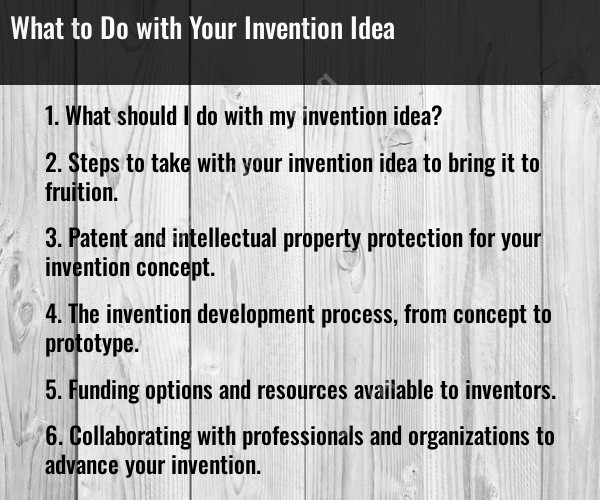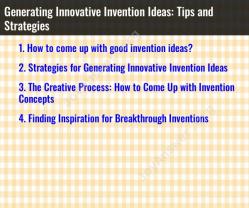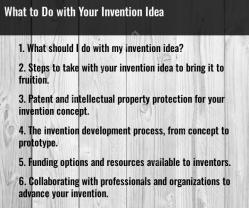What should I do with my invention idea?
Bringing your invention idea to life and potentially turning it into a successful product or business can be an exciting and rewarding journey. Here are steps to consider when you have an invention idea:
Research and Validate Your Idea:
- Start by researching your idea to determine if there's a market for it.
- Check if similar products or inventions already exist.
- Assess the potential demand for your invention and identify your target audience.
Protect Your Invention:
- Consider getting intellectual property protection, such as a patent, trademark, or copyright, depending on the nature of your invention.
- Consult with an intellectual property attorney to understand your options and protect your idea.
Develop a Prototype:
- Create a working prototype or a detailed design of your invention to demonstrate how it works.
- A prototype can help you test and refine your concept, making it more attractive to investors or potential partners.
Market Research:
- Conduct market research to gain a deeper understanding of your target audience, competition, and pricing strategies.
- Collect feedback from potential users to refine your invention.
Business Plan:
- Create a comprehensive business plan that outlines your invention, market analysis, marketing and sales strategies, financial projections, and a roadmap for development and growth.
Funding and Financing:
- Determine how you will fund the development and commercialization of your invention. Options include personal savings, loans, grants, crowdfunding, or seeking investors.
Build a Team:
- Consider building a team if your invention requires diverse skills and expertise, such as product development, marketing, legal, and financial management.
Prototyping and Testing:
- Continue refining and testing your invention. Make improvements based on user feedback and market demand.
Manufacturing and Production:
- If your invention is a physical product, explore manufacturing options and supply chain logistics.
Marketing and Branding:
- Develop a branding and marketing strategy to promote your invention to your target audience.
- Consider creating a website, social media presence, and marketing materials.
Distribution and Sales:
- Determine how you will distribute and sell your invention, whether through e-commerce, retailers, or other channels.
Legal and Regulatory Compliance:
- Ensure that your invention complies with all relevant laws and regulations, including safety standards, licensing, and labeling requirements.
Launch and Promotion:
- Plan a launch event or campaign to introduce your invention to the market.
- Seek media coverage and leverage social media for promotion.
Scaling and Growth:
- As your invention gains traction, explore opportunities for scaling and expanding your business.
Adapt and Evolve:
- Be prepared to adapt and evolve your invention and business based on market feedback and changing circumstances.
Protect Your Intellectual Property:
- Continue to protect your intellectual property and be vigilant about potential infringements.
Remember that turning an invention into a successful product or business can be a challenging and time-consuming process. It often requires dedication, perseverance, and a willingness to learn from setbacks and failures. Seeking guidance from mentors and professionals in relevant fields can be invaluable as you navigate this journey.
Steps to take with your invention idea to bring it to fruition:
Research your idea. Before you invest too much time and money into developing your invention, it's important to do your research to make sure that it is feasible and marketable. This includes conducting patent searches to see if there are any existing patents on similar inventions, and conducting market research to see if there is a demand for your product or service.
Develop a prototype. Once you have determined that your invention is feasible and marketable, you need to develop a prototype. This is a working model of your invention that you can use to test its functionality and make necessary modifications. You may be able to develop the prototype yourself, or you may need to hire a professional to help you.
Apply for a patent. A patent is a government grant that gives you the exclusive right to make, use, and sell your invention for a period of 20 years. Applying for a patent can be a complex and time-consuming process, so it is important to consult with an experienced patent attorney.
Seek funding. Developing and marketing an invention can be expensive. If you don't have the personal resources to fund your invention, you may need to seek funding from investors or government grants. There are a number of resources available to help inventors find funding, such as the Small Business Innovation Research (SBIR) program and the National Science Foundation (NSF).
Market your invention. Once you have developed your invention and secured funding, you need to market it to potential customers. This includes developing a marketing plan, identifying your target market, and creating marketing materials. You may also need to attend trade shows and other events to promote your invention.
Patent and intellectual property protection for your invention concept:
A patent is a legal document that grants the inventor the exclusive right to make, use, and sell an invention for a period of 20 years. A patent protects the invention from being copied or used by others without the inventor's permission.
Intellectual property (IP) refers to intangible property that is the result of human creativity. IP includes inventions, designs, trademarks, and copyrights. IP protection is important for inventors because it allows them to control their inventions and prevent others from copying them.
The invention development process, from concept to prototype:
The invention development process is the process of taking an invention idea from concept to a marketable product or service. The process can be divided into four main stages:
- Concept development: This stage involves brainstorming ideas, conducting research, and developing a detailed concept for the invention.
- Prototype development: This stage involves building a working model of the invention to test its functionality and make necessary modifications.
- Product development: This stage involves refining the prototype and developing a manufacturing process for the invention.
- Market launch: This stage involves developing a marketing plan and launching the invention to the market.
Funding options and resources available to inventors:
There are a number of funding options and resources available to inventors, including:
- Self-funding: Many inventors use their own personal resources to fund the development and marketing of their inventions.
- Investor funding: Investors can provide inventors with the capital they need to develop and market their inventions.
- Government grants: There are a number of government grants available to inventors, such as the SBIR program and the NSF.
Collaborating with professionals and organizations to advance your invention:
There are a number of professionals and organizations that can help inventors advance their inventions. These include:
- Patent attorneys: Patent attorneys can help inventors with the patent application process and provide legal advice on IP protection.
- Product development consultants: Product development consultants can help inventors with the development and manufacturing of their inventions.
- Marketing consultants: Marketing consultants can help inventors develop and execute marketing plans for their inventions.
- Business incubators and accelerators: Business incubators and accelerators provide inventors with resources and support to help them grow their businesses.
Overall, there are a number of steps that inventors can take to bring their invention ideas to fruition. By following these steps, inventors can increase their chances of success in developing and marketing their inventions.




